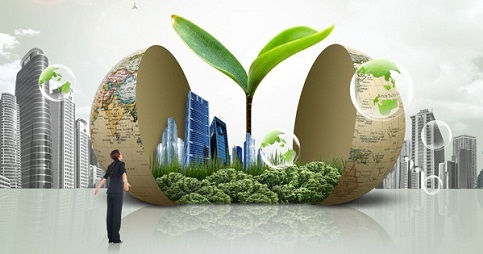Global green building materials market
Introduction
Though cost concerns, market barriers and lack of government policies encouraging green construction are some factors which hinder the growth of green building materials, continuous innovation and a rise in the growth of the building and construction sector provides great potential for market expansion.
Green building materials promote the conservation of non-renewable resources and reduce environmental impact associated with fabrication, processing, installation, transportation, disposal, and recycling.
They are employed in the construction industry to address environment challenges including climate change, natural resource depletion, atmospheric pollution, contamination of fresh water resources, and loss of biodiversity.
The emission reduction potential of green building materials, high asset value of green buildings, growth in public awareness, and an increase in client and market demand are the major factors that drive the green building materials market across the globe. Increasing concerns regarding energy prices, accelerating climate change, negative health impacts associated with building materials, and stormwater runoff polluting rivers and lakes have reinforced the need for green building construction in the residential sector.
DGNB, LEED, BREEAM, HQE, and EnergyStar are some of the certification systems that evaluate performance of the green buildings.
New low-rise and high residential buildings, retrofits of existing buildings, and new industrial buildings are the major areas where growth of green building materials is expected.
Exterior products accounted for more than one-third of the market in terms of revenue in 2015. Employment of green building exterior products in construction industry offers energy efficiency, durability, low maintenance, and operation cost and waste reduction over traditional construction techniques. The residential buildings segment holds the largest share by application in terms of revenue and is expected to grow at a CAGR of 11.2%.
Porter’s Five Forces Analysis
Green building employs pollution-free production technology and low-energy manufacturing processes, which helps control expenses and environmental hazards. The demand for raw materials used in green building materials market has increased considerably over the years, whereas the sources from which these raw materials are derived are limited in nature.
Market Dynamics:
Drivers:
Emission Reduction Potential of Green Building Materials
The building and construction sector accounts for more than two-thirds of total greenhouse gas emissions across the globe. Thus, there is a great potential for reducing greenhouse emissions by enhancing the energy efficiency of buildings and communities. Reductions in greenhouse emissions can be accomplished by the construction of new green buildings with low energy consumption and retrofitting of existing buildings.
Restraints:
Cost Concerns and Market Barriers
A wide variety of cost concerns and market barriers exist in the green building construction market including the “split incentive” barrier, i.e., owners of the houses don’t make effective investments in their properties as the occupants reap benefits from these investments and not the owners. A total of 40% of commercial buildings and 32% of households are rented or leased.
Top Winning Strategies:
To withstand competition, the key players in the global green construction materials industry have adopted different key business strategies, such as acquisitions, expansions, product launch, and collaboration.
Key findings of the Green Building Materials Market:
- Asia-Pacific is expected to continue to lead the market during the forecast period followed by Europe.
- Solar products market revenue is projected to grow with a high CAGR of 13.5% during the forecast period.
- Roofing is the fastest growing segment in green building exterior products registering a CAGR of 12.2% during the forecast period.
- Brazil accounts for three-fifths share in LAMEA green building materials market in 2015.
- India grows at a faster rate in Asia-Pacific green building materials market, registering a CAGR of 12.7% from 2016 to 2022.
- France accounts for 11.1% share in Europe green building materials market in 2015.
Related articles on Designing Buildings Wiki
Featured articles and news
OpenUSD possibilities: Look before you leap
Being ready for the OpenUSD solutions set to transform architecture and design.
Global Asbestos Awareness Week 2025
Highlighting the continuing threat to trades persons.
Retrofit of Buildings, a CIOB Technical Publication
Now available in Arabic and Chinese aswell as English.
The context, schemes, standards, roles and relevance of the Building Safety Act.
Retrofit 25 – What's Stopping Us?
Exhibition Opens at The Building Centre.
Types of work to existing buildings
A simple circular economy wiki breakdown with further links.
A threat to the creativity that makes London special.
How can digital twins boost profitability within construction?
The smart construction dashboard, as-built data and site changes forming an accurate digital twin.
Unlocking surplus public defence land and more to speed up the delivery of housing.
The Planning and Infrastructure Bill
An outline of the bill with a mix of reactions on potential impacts from IHBC, CIEEM, CIC, ACE and EIC.
Farnborough College Unveils its Half-house for Sustainable Construction Training.
Spring Statement 2025 with reactions from industry
Confirming previously announced funding, and welfare changes amid adjusted growth forecast.
Scottish Government responds to Grenfell report
As fund for unsafe cladding assessments is launched.
CLC and BSR process map for HRB approvals
One of the initial outputs of their weekly BSR meetings.
Building Safety Levy technical consultation response
Details of the planned levy now due in 2026.
Great British Energy install solar on school and NHS sites
200 schools and 200 NHS sites to get solar systems, as first project of the newly formed government initiative.
600 million for 60,000 more skilled construction workers
Announced by Treasury ahead of the Spring Statement.

























